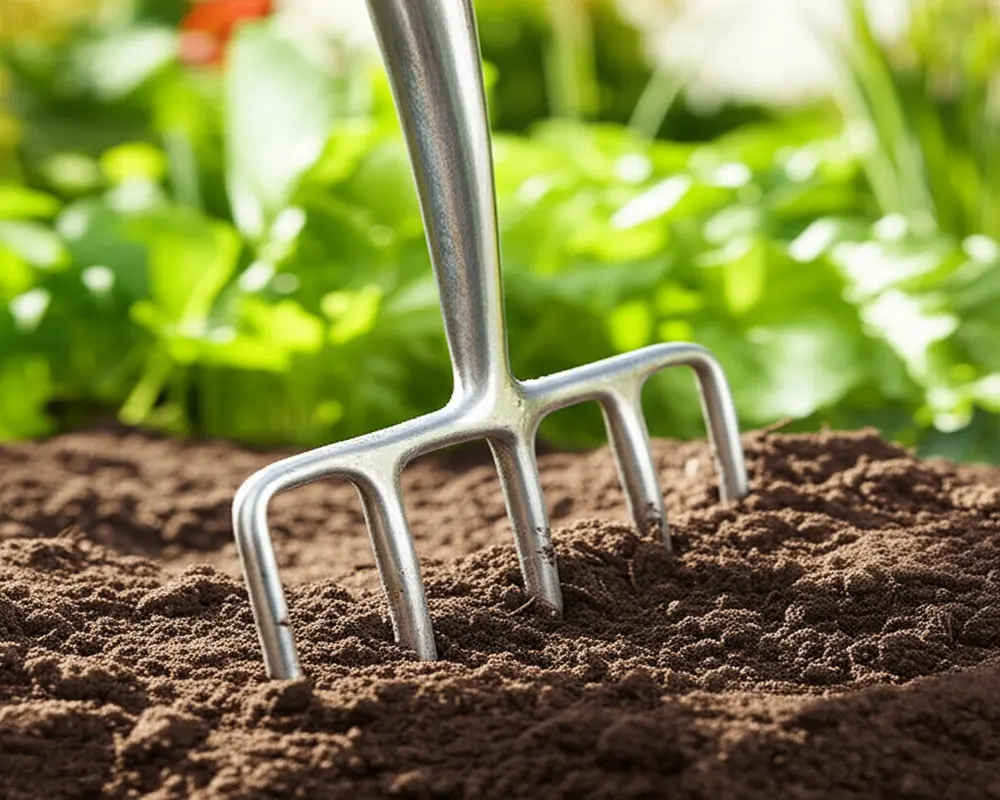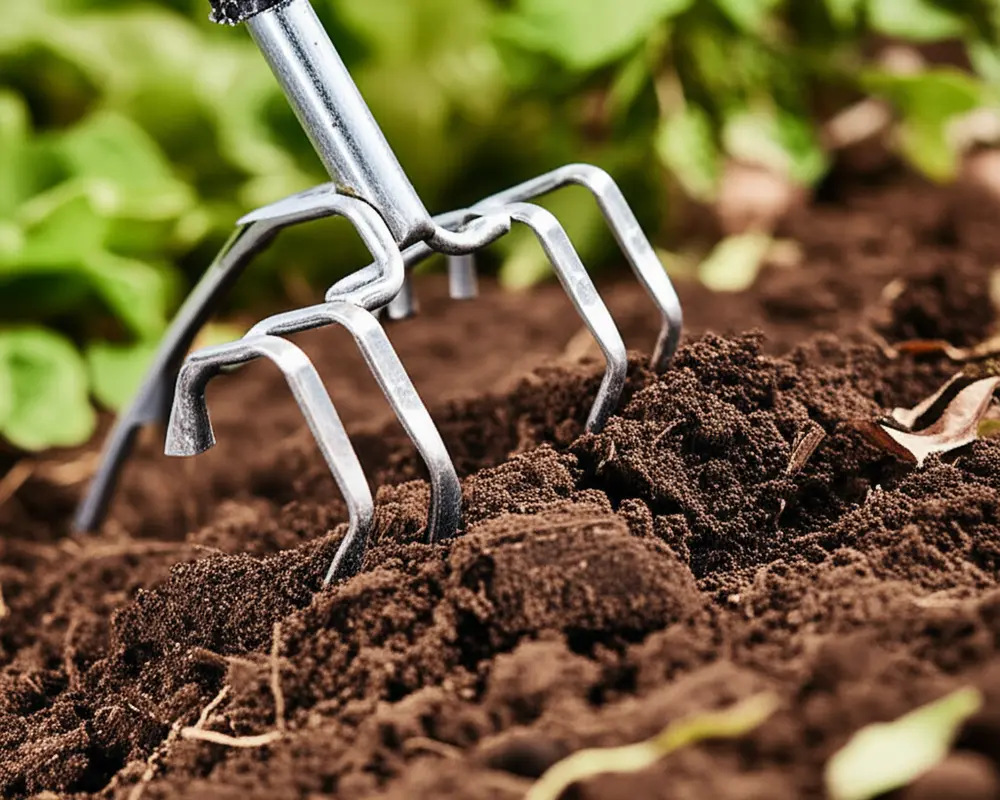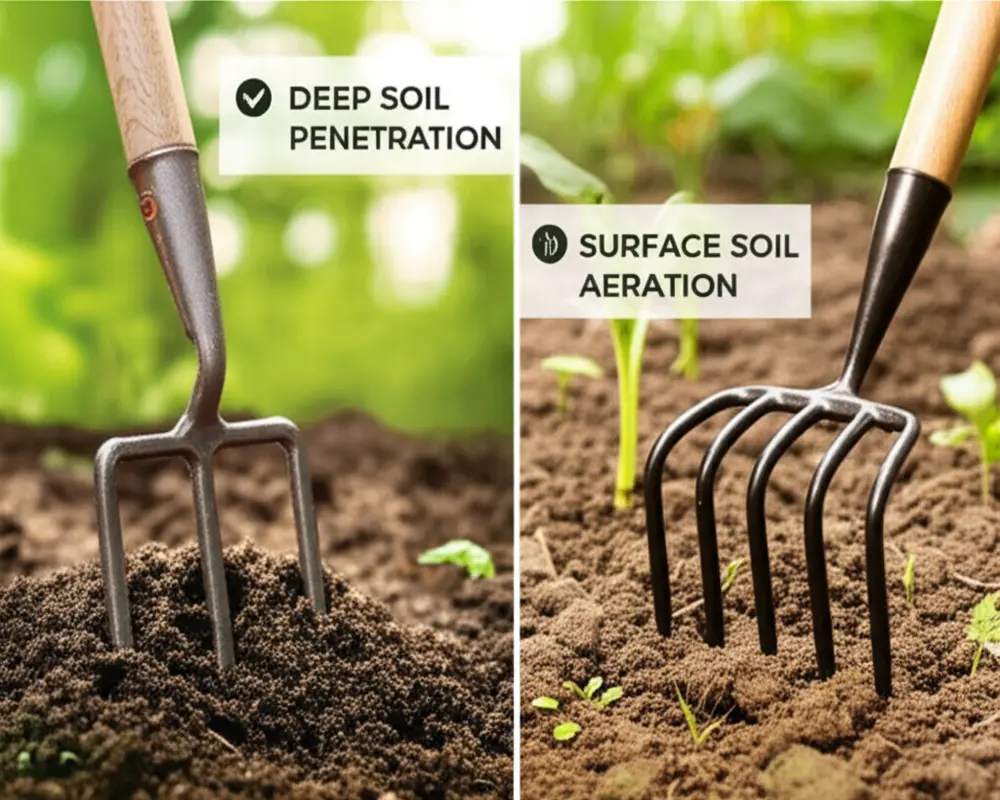Starting a garden or tackling new soil? Selecting the right tool can be the deciding factor between effortless gardening and frustrating labor. Two fundamental tools often compared are the garden fork vs cultivator. Each serves distinct purposes tailored to different soil types, garden sizes, and tasks.
Thank you for reading this post, don't forget to subscribe!This guide explores those differences, helping you pick the ideal tool for your gardening needs. By the end, you’ll understand not just the distinctions but practical applications, ensuring your soil gets the care it deserves.
Understanding the Garden Fork
A garden fork is a hand tool featuring a long handle, typically crafted for comfort and leverage, connected to a head with several strong, sharp tines. Most garden forks come with four tines, either flat or square-shaped, often slightly curved to facilitate soil penetration and lifting.
Its core strength lies in breaking up dense, compacted, or virgin soil where forceful leverage and piercing in depth—ranging from 6 to 12 inches or more—are necessary. Garden forks excel in turning over soil for aeration and mixing soil amendments like compost or manure. Beyond soil preparation, these forks are invaluable when transplanting plants or lifting sod without damaging roots. Additionally, they are handy for harvesting root vegetables such as potatoes and carrots due to their robust tines designed for gentle lifting.

Various types include:
- Digging Fork: A robust type with square tines for heavy-duty digging.
- Border Fork: Smaller and lighter, designed for more delicate soil areas or borders.
- Broadfork: Used mainly for no-dig garden beds, offering deep aeration while minimizing soil disturbance.
The garden fork’s design makes it irreplaceable for heavy soil work and mechanical soil penetration, an essential tool for breaking new ground or managing clay-heavy or compacted soils.
Understanding the Cultivator
In contrast, a cultivator is designed primarily for surface soil work. Its purpose ranges broadly from loosening soil and aerating established beds to uprooting shallow weeds and prepping seedbeds for planting.
The design of cultivators varies considerably, reflecting their versatile applications. Handheld cultivators often have claw-like tines for precision, suitable for small areas and spot-weeding. Wheeled cultivators or hoes cover larger manual areas, ideal for row cultivation. Meanwhile, powered cultivators—electric for smaller gardens and gas-powered for larger or tougher soil—offer more efficiency with rotary blades or tiller mechanisms.

Besides loosening soil in the upper 1 to 6 inches, cultivators assist in mixing light soil amendments or fertilizers into existing beds, perfect for maintenance rather than initial soil breaking. They help maintain weed-free paths and keep beds aerated without deep disturbance.
Types of Cultivators
- Manual Cultivators:
- Hand cultivators with claw tines for detailed work.
- Wheeled cultivators or hoes for larger areas requiring row cultivation.
- Powered Cultivators:
- Electric cultivators suited for ease of use and smaller landscapes.
- Gas cultivators designed for more power and larger garden areas.
At times, powerful cultivators blur into tiller territory, which focuses on deeper soil turning and preparation beyond surface level.
Garden Fork vs Cultivator: A Side-by-Side Comparison

| Feature | Garden Fork | Cultivator |
|---|---|---|
| Primary Use | Breaking, turning, lifting heavy soil | Aerating, weeding, mixing, fine soil prep |
| Soil Depth | Deep (6-12+ inches) | Shallow (1-6 inches) |
| Soil Type | Heavy, compacted, virgin soil | Looser, established, well-worked soil |
| Effort Level | High (requires physical strength) | Moderate to low (varies by manual vs powered) |
| Precision | Less precise; broad strokes | High precision (manual); moderate (powered) |
| Best For | New beds, transplanting, harvesting root crops | Maintaining established beds, weeding, seedbed prep |
| Cost | Low to moderate (generally manual) | Low (manual) to high (powered) |
Functionality and Depth of Work: The garden fork breaks through tough soil with its leverage, working deeply and disrupting hard-packed layers, whereas the cultivator is effective at churning and loosening only the topmost soil layer.
Soil Aeration: For deep aeration, forks penetrate well below the surface, enhancing water and air penetration to roots. Meanwhile, cultivators excel at surface-level aeration, keeping the soil loose and weed-free.
Weeding: For deep-rooted weeds, garden forks can dig them out effectively, while cultivators clear shallow weeds with precision, especially hand cultivators.
Soil Type Suitability: Garden forks thrive in heavy clay and compacted soils, breaking tough ground, while cultivators are better suited to sandy or loamy soils where less force is needed.
Effort and Ergonomics: While garden forks demand more physical strength, hand cultivators reduce strain with their lightweight design. Powered cultivators lessen effort significantly, albeit at a higher cost and with noise and maintenance considerations.
Speed and Efficiency: For initial soil breaking, garden forks are irreplaceable despite slower work pace. Cultivators, especially powered types, provide faster maintenance and preparation for seedlings.
When to Use a Garden Fork
Garden forks become indispensable in several specific scenarios:
- While breaking new ground or creating fresh beds from untouched soil.
- When incorporating large amounts of compost or manure into heavy soil.
- For carefully lifting established perennials or tightening spaces without damaging roots.
- Harvesting root vegetables like potatoes or carrots where lifting without bruising is needed.
- For deep aeration of compacted lawns or garden beds.
If your gardening tasks echo any of these requirements, the garden fork is the go-to tool, offering strength and versatility unmatched by cultivators.
When to Use a Cultivator
The cultivator’s strength lies in its capability to maintain and lightly prepare soil for planting. Suitable use cases include:
- Preparing fine seedbeds for delicate seeds that need surface-level attention.
- Removing shallow weeds between rows of plants efficiently.
- Light aeration of garden beds with established plants, ensuring the soil stays loose.
- Incorporating fertilizers or topdressing gently into the soil’s upper layers.
- Breaking up the soil crust after rain to enhance water absorption.
- Maintaining weed-free paths, especially when using powered cultivators.
For these lighter, repetitive tasks, cultivators provide finesse and speed.
Which Tool Do You Really Need? A Decision Guide
Your choice should primarily depend on:
Primary Gardening Tasks: Are you initiating new beds that require soil breaking and heavy digging, or are you mostly maintaining existing beds with weeding and light soil prep?
Soil Type: For dense clay and untouched soil, a garden fork is essential. For sandy or loamy soils, cultivators often suffice.
Garden Size: Small raised beds might be best managed with manual options, while larger vegetable patches may benefit from powered cultivators and a garden fork combination.
Physical Strength and Budget: Manual garden forks require more effort but cost less, while powered cultivators offer ease at a higher price and upkeep.
Quite often, the best approach is to equip yourself with both tools. A garden fork handles the heavy lifting, soil breaking, and transplanting, while the cultivator maintains soil health, aeration, and weed control with precision. This complementary pairing benefits any serious gardener.
Beyond the Basics: Care, Maintenance, and Safety
Proper upkeep extends the life and performance of your tools:
- Cleaning: Always remove soil and debris immediately after use. Dry tools thoroughly to prevent rust.
- Sharpening: While garden forks typically do not require sharpening, some cultivator tines benefit from occasional sharpening to maintain efficiency.
- Storage: Store tools in a dry, sheltered place, ideally hanging or off the ground to avoid moisture contact.
Safety Tips: Wear sturdy footwear and gloves to protect from injuries. Use proper body mechanics to avoid strain, especially when using manual forks which demand high physical effort. Remain aware of your surroundings with powered cultivators, as blades or tines rotate rapidly and can cause injury.
Complementary tools like a garden spade or rake can enhance soil prep and garden maintenance efficiency.
Frequently Asked Questions (FAQs)
Can a garden fork be used as a cultivator for weeding?
While a garden fork can uproot deep-rooted weeds, it lacks the precision of a cultivator, especially for surface-level weeding. The fork’s broad tines can disturb plants and soil more deeply than intended.
Is a cultivator better than a hoe for weeds?
Cultivators, especially hand claw types, can be more precise and less disruptive than traditional hoes for shallow weeding. However, hoes are efficient for broader sweeps over larger, less dense areas.
What’s the difference between a garden fork and a pitchfork?
A garden fork has shorter, sturdier tines designed for soil work, while a pitchfork features longer, wider-spaced tines meant for moving loose materials like hay or mulch.
How deep can a cultivator go?
Manual and powered cultivators typically work the top 1 to 6 inches of soil, sufficient for aeration, mixing light amendments, and weed removal.
Which is better for no-dig gardening?
The broadfork is ideal for no-dig gardening due to its ability to gently aerate soil deeply without turning it over, preserving soil structure and microbial life more than typical forks or cultivators.
Conclusion: Empowering Your Gardening Choices
The choice between a garden fork vs cultivator hinges on your garden’s unique needs. For breaking and deeply turning heavy soils, lifting, and root harvesting, the garden fork reigns supreme. For daily maintenance, weeding, and fine soil preparation, cultivators hold distinct advantages, especially when powered versions come into play.
Understanding your soil type, garden size, and gardening tasks helps clarify which tool or tool combination offers you the best efficiency and results. Equipped with the right knowledge and tools, you are poised to cultivate a thriving garden with confidence.
For more insights on essential garden tools like spades, consider exploring our detailed guides on best garden spades 2025 and ergonomic garden spades to complement your gardening toolkit.
Additional references:
- The expert Bob Vila guide on garden fork vs cultivator provides further practical comparisons.
- Detailed usage tips are available at Gardener’s Path.
- For tool manufacturing insights, check Ames True Temper’s official blog.

